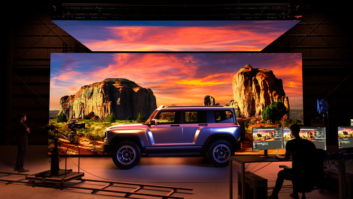NAB News:Sony is working with rig developer Element Technica to devise a 3D production workflow for episodic TV, writes Adrian Pennington. Sony’s PMW-F3 Super 35mm camera and its MPE-200 processor are being tested and integrated with Element Technica rigs.
There is clear momentum among manufacturers at NAB toward the streamlining of technologies and production workflows for live and pre-recorded 3D TV. There is also momentum from at least one US TV studio driving this initiative forward, TVB Europe understands.
Sony and Element Technica continue to collaborate on the live 3D production of sports, including Wimbledon in 3D in July, but they have also begun tests aimed at episodic production.
“For recorded 3DTV what is needed is a streamlining of the whole process from smaller, lighter cameras to a more efficient means of identifying disparities between the lenses and correcting them in post,” explained Element Technica co-founder Stephen Pizzo.
One part of this is a pair of new mounts built by ET to enable F3s to be mounted side by side or under and over on a Pulsar rig.
The second part of the workflow sees the MPE200 being used for analysis rather than correction, with the information passed downstream as metadata. A demonstration of this approach was being shown on ET’s booth at NAB.
A similar workflow was previously announced by Element Technica in conjunction with SGO and its Mistika Live analysis platform. Pizzo said that Element Technica is open to working other manufacturers in this space, including Fraunhofer IIS, Avid and Iridas.
What we are not doing is baking in any corrections to the images as they are shot,” explained Pizzo. “Instead we taking the interocular and convergence data from the rig, feeding that to the MPE-200, which analyses the images for disparity in colourimetry, exposure and geometry and sends that information back to the rig. All of that metadata is then collected in an IO Module along with timecode and made available for post production. So for dailies creation or serial grading operators have the original analysis along with rig data and lens parameters available to help apply corrections much more quickly than they can at present.”







